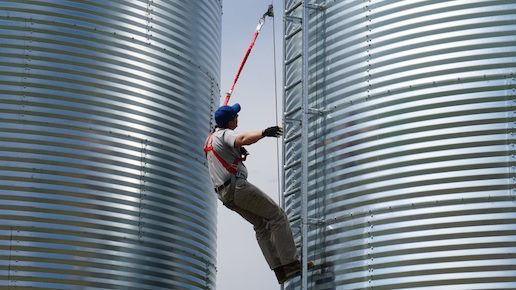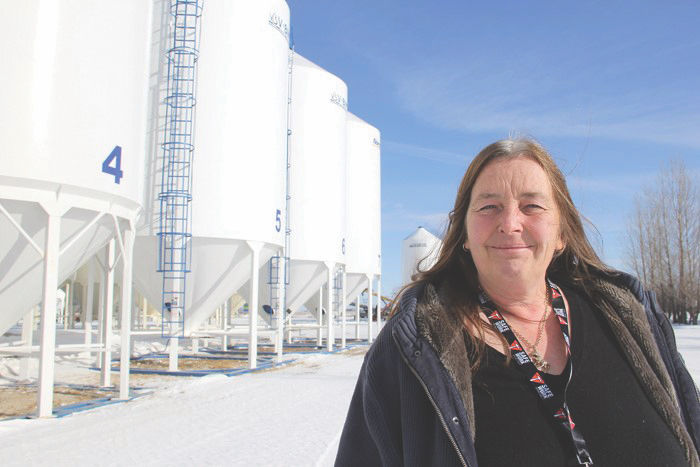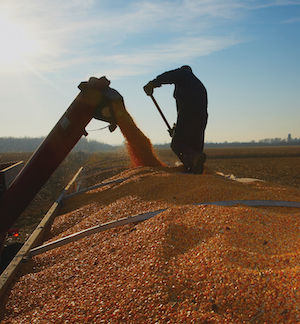5 READ-TIME
Proper fall protection equipment saves lives
December 5, 2023

By Trevor Bacque
Greg Setter, farmer and owner of Setter Manufacturing Division, remembers that harrowing Sunday in 2014 as though it were yesterday.
The November landscape was already frozen after harvest and the Russell, MB farmer was conducting final bin checks before driving out to an Alberta trade show. He had scaled his 4,000-bushel bin, which is about 22 feet high, hundreds of times. It was simply routine for Setter, who was 63 at the time.
On one of his final checks, he clipped in his safety line, climbed the ladder and made it to the top. As he climbed onto the angled portion of the bin roof, he realized there wasn’t enough rope, so he reached backward and unclipped, but he lost his balance and began to fall to the ground below, back first. Miraculously, he had the wherewithal to “fight like heck” and save the landing.
“If I would have stayed falling the same way I was, my head would have hit the aeration fans and that would have been it,” he says.
Setter landed directly on his feet. His right leg buckled under the pressure and kicked himself in the backside. The fall broke his pelvis in four places. In a state of shock, he climbed the bin again to inspect the grain. He believes going back up helped re-align his pelvis enough to avoid surgery. Instead, he lay in a hospital bed unable to put any pressure on his legs for six weeks, noting, “I was lucky.”
As scary as Setter’s story is, Morag Marjerison doesn’t even bat an eye. As the farm safety consultant for Keystone Agricultural Producers, she’s heard many tales like Setter’s, including some where the luck ran out. She says that falls happen way more often than people think but getting precise stats is difficult because most falls go unreported — either farmers don’t hurt themselves or are embarrassed. And that needs to change.
BUT IF YOU WANT TO RETROFIT
One company that has taken a serious approach to bin safety and fall prevention is Northern Strands in Saskatoon, SK. Its award-winning Bin Safe System is garnering a favourable response from farmers.
Operations Manager Laura Toews says the company began selling the system in 2017 and it was so well received that bin manufacturers began to buy Bin Safe and offer it to customers as part of their packages. Part of the allure is that the device is Occupational Health and Safety, Canadian Standards Association and American National Standards Institute compliant.
The Bin Safe System connects a user from the ground right up to the bin lid without unclipping (patent-pending) and can be installed on an average corrugated or smooth walled bin in about 20 minutes. Per bin, a kit ranges between $180 to $245 and the user kit, which includes a lanyard, harness and rope grab, is $430 and usable on all bins.
“If you have employees and you’re paying them a wage, you have a responsibility to provide them with a safe work environment,” Toews says. “Failure to do so leaves you as the employer, open to liability. A lot of people misunderstand that if you are a corporate farm, you’re exempt from that, but you’re not. No employer is exempt from ensuring their employees are safe.
“It’s not a matter of if it’s going to happen, it’s a matter of when it’s going to happen. It’s going to cost you a couple hundred bucks per anchor. (Farmers) just have to look around their family supper table. There’s your reason for getting it.”
5 Safety tips for working around bins
- Talk! Clinical studies show that speaking about a situation, especially in positive terms, provides better outcomes. Make sure everyone has a conversation about safety, whether it seems like common sense or not. You are always better off safe than sorry.
- Inspect Whether it’s a stand-alone or an affixed ladder, regularly inspect them to ensure everything is safe. Welds that are letting go or rungs that require replacement should be fixed immediately.
- Secure stand-alone ladders This may be a rope or some other means, but it must be in place before you climb. Situations are regularly reported where a farmer reaches the top of a bin and a ladder falls, leaving him stranded and vulnerable. Never put yourself in this situation.
- Buddy up Guarantee at least one other person always knows where you are. It’s common for farms to have multiple bin yard sites. If nobody knows where you are and an incident occurs, this could potentially be a fatal oversight.
- Have a means of communication on your person Too often farmers leave their cellphones in the truck. Always have your phone on you, no exceptions. Should you fall, you may be able to call 9-1-1 or a fellow worker, possibly saving your life.

Morag Marjerison, farm safety consultant for Keystone Agricultural Producers insists there is no reason to fall or deal with a farmyard safety issue alone. She offers these five safety tips for working around bins.

